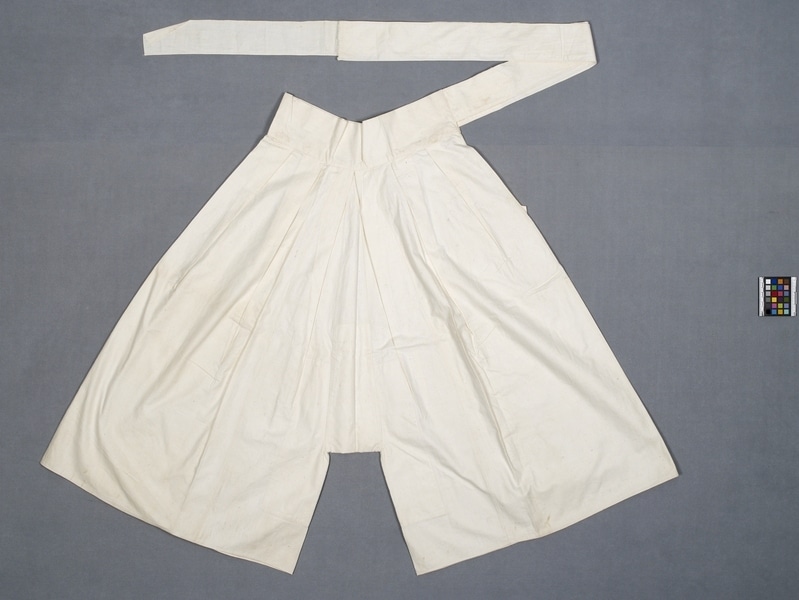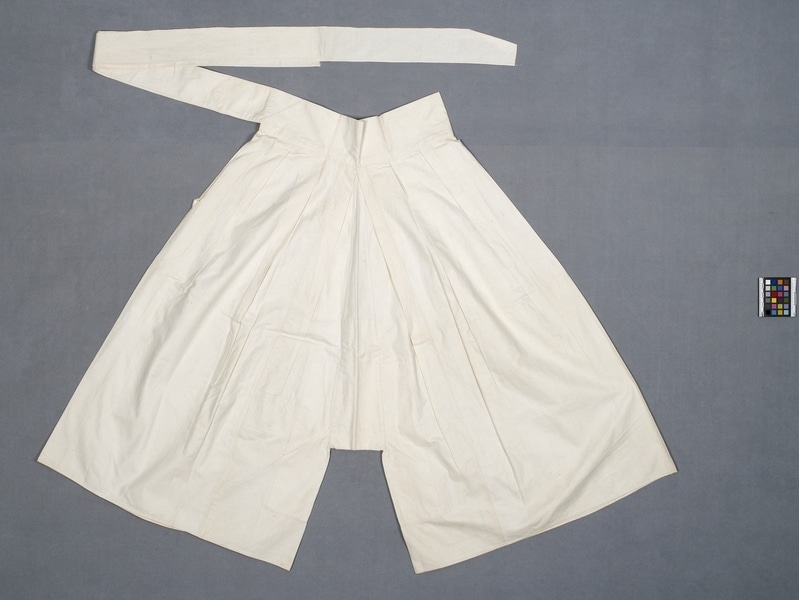Underwear Item Number: 984/4 from the MOA: University of British Columbia


Description
Under-trousers of unbleached heavy white cotton fabric. The underwear has a wide cotton waistband. There is an opening on the right side, closed by wide ties. The wide pant legs are pleated into the waistband; the three pleats on each side face the centre seam, front and back. A triangular panel is inserted between the legs, ending below the knees. The panel is lined with the same cotton fabric, which extends into adjacent areas of the pant legs. The rest of the underwear is unlined.
History Of Use
Such under-trousers would have been worn by a woman of any age from the official “yangban” class, as the outermost layer of underpants, under the under skirt “Sok-chima” or as the innermost layer of underpants. They are very wide to add bulk under the woman’s skirt “Chi-ma”. Women could urinate through the wide leg opening. After about 1930 the Japanese imposed the wearing of Japanese-style under-trousers “Mom-pe” so that women could work more effectively. During the 19th century, women’s underwear generally had a crotch slit that continued to the front, but this was later simplified during the modernization of Korea and the slit limited to the back. Later, shoulder straps were added. More elaborated underwear had additional flaps at the crotch to ensure that the skin was covered, which was very important during the Chosun Dynasty. Ordinary people wore more simple underwear, the construction of which was not elaborated. Only women’s and girl’s under-trousers had the slit; men’s did not. Men also did not wear as many layers of underwear as women did. Women of the official “yangban” class wore the following layers of lower-body underwear: a loincloth that passed between the legs and fastened front and back to a waistband (“Da-ri-sok-got”); wide, straight-legged under-trousers with a side opening with ties and with flaps (“Sok-sok-got”); back- or side-opening under-trousers tapering to the ankles with a crotch-slit and with flaps at the opening (“Sok-ba-ji”); wide, straight-legged under-trousers with flaps (“Dan-sok-got”); under-skirt (“Sok-chima”); and outer skirt (“Chima”). Many layers of underwear were important to add bulk for elegance, and to protect their virginity. Underwear was tied below the wearer’s breasts, and extended to the back of her foot. Entertainers, “Gae-seng”, might intentionally show their ankles and the edges of their underwear. Underwear was and is boiled as part of the laundry process. In the 1930s, such machine-sewn underwear could have been made at home by a skilled maid, or by specialists in the market.
Specific Techniques
Sewn with very fine machine sewing. Body of pants was pleated onto waistband, which was sewn inside out. Seams are doubled over and stitched a second time.
Item History
- Made in Korea during 1930
- Owned by Hi Soon Kim before August 7, 1984
- Received from Hi Soon Kim (Seller) and Unknown (Funding source) on August 7, 1984
What
Who
- Culture
- Korean
- Previous Owner
- Hi Soon Kim
- Received from
- Hi Soon Kim (Seller) and Unknown (Funding source)
Where
- Holding Institution
- MOA: University of British Columbia
- Made in
- Korea
When
- Creation Date
- during 1930
- Ownership Date
- before August 7, 1984
- Acquisition Date
- on August 7, 1984
Other
- Item Classes
- textiles
- Condition
- good
- Accession Number
- 0984/0004